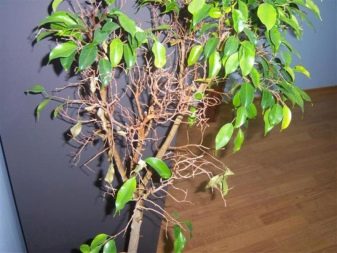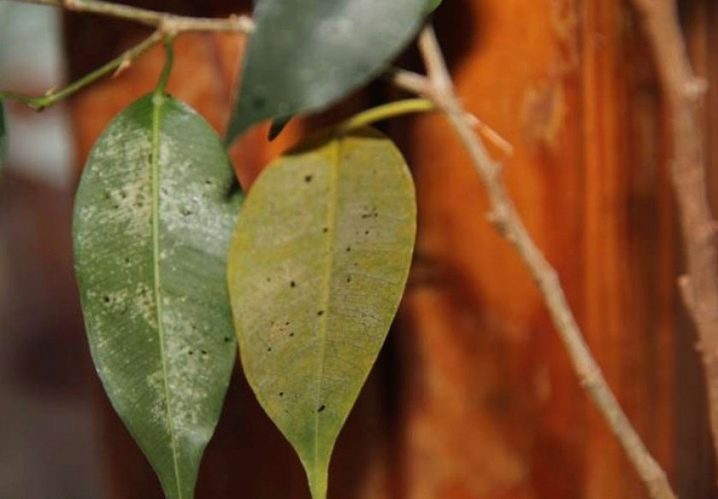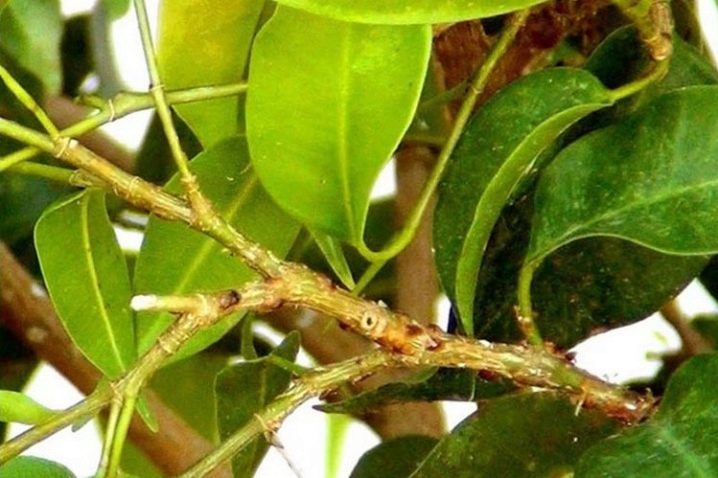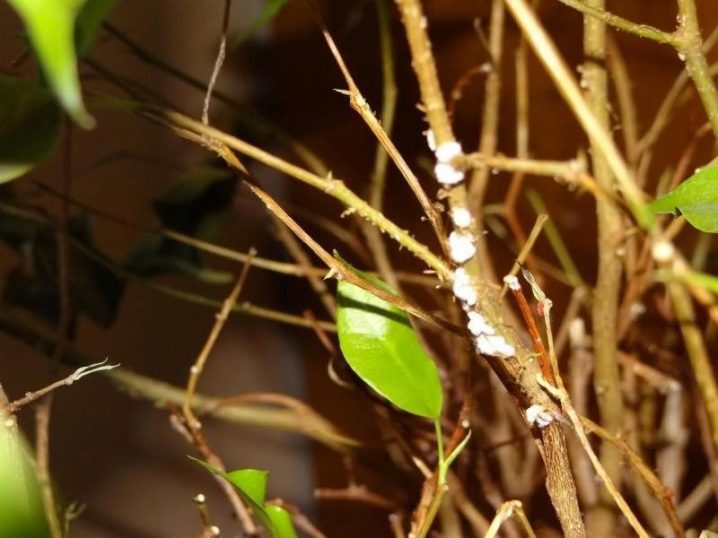Diseases and pests of ficus Benjamin

Ficus is quite resistant to pests and diseases, but it so happens that it is frozen or dries up. The main symptom of a plant disease is falling leaves or the appearance of plaque and spots on them. Knowing how to deal with a problem requires understanding the cause.
Common problems
If the growing conditions are not followed, then the ficus will not look healthy. It is not necessary for the bush to be affected by insects or disease, sometimes the problem is associated with insufficient lighting. The pallor and yellowing of the leaves indicates the lack of the required amount of light. In this case, you just need to move the pot closer to the window, and in winter add artificial lighting.


The appearance of brown spots is a sign of a burn from direct sunlight.
It also happens that the fall of foliage and the appearance of blackening is the result of frostbite of the plant. You can revive the plant at home. The most important thing is to eliminate the source of the draft, create conditions for resuscitation. In no case should you water the flower, you need to wait for the soil to dry well. The necessary moisture is given by spraying the foliage with warm and settled water. As soon as new shoots appear, it is allowed to resume watering and use "Kornevin" - a growth activator. Orton Rost is used as a top dressing 2 times every week.
If the flower dries up or has already dried up, then you need to restore it immediately. To do this, use high-quality watering and a lot of scattered light in combination with stimulants. The root system is freed from soil and placed in water, waiting for new shoots to appear.

Diseases
Benjamin ficus diseases always develop due to unfavorable growing conditions. The main reasons for this are low temperatures (below 60 ° F) and over-watering. Effective tips for maintaining a healthy plant are to use a pathogen-free planting soil and container, and a disease-free seedling. It is worth taking a closer look at common problems with ficus and how to solve them.
- Leaf fall... This is the most common problem for novice growers and is usually caused by temperature changes. Ficus loves constant conditions, therefore it is necessary to maintain the same level of heat and humidity. A change in these two factors, even within the range of 5-10 degrees, will lead to leaf fall. The only way to fix the problem is to stabilize the environment and continue to water and fertilize the flower regularly.
- Brown spots. Cercospora looks like tiny black dots on the leaves. In this case, they can turn yellow and fall off. The grower will need to remove diseased shoots and spray the plant with a specialized agent, and subsequently prevent high humidity. The use of sulfur helps, it is sold in sprays. Copper fungicides can be used at the first sign of illness to prevent its spread. Organic products will prevent spore germination.
- Anthracnose... This disease manifests itself as rusty spots on the stems and leaves. When a problem arises, diseased leaves are removed, and in the future they practice good sanitation. Collecting and disposing of all affected plant parts and providing adequate light, water and fertilizer will strengthen the plant's ability to resist fungus.Chemical treatments are rarely used because indoors they can be harmful to occupants.
- Juice oozes from the ficus. This condition is caused by the appearance of sucking pests. Mealy bugs look like small cotton bunches, and the scales look like white or black spots on the stems and body of the tree. The problem is eliminated by using horticultural oils or soap solution - 1 tablespoon of soap per 4.5 liters of water.
- The appearance of inflamed areas. Such swollen areas can form on leaves (in large veins), stems, and sometimes roots, near stem cuttings. It is caused by a bacterium. It can be destroyed by removing the affected plant parts to prevent spread. Using herbal sprays containing copper is an effective treatment for this condition.
- Black spots. Very small marks usually develop on the underside of the leaves. This is nothing more than a fungus; with a very strong infection, the foliage turns yellow and falls off over time. You can prevent further spread of the disease by removing the infected areas and spraying with a fungicide. Spotting can also be caused by an aphthous lesion. The stains may appear rusty and may ooze at times.

Harmful insects
Some plants are better suited to pest control, while others need extra help. Before buying ficus, it is important to study what problems are typical for these beautiful trees.
- Mealybug. They are small, white, fluffy sucking insects that congregate in large clusters. They can appear after watering, as they crawl to the surface of the soil. They can be seen in areas of the plant where the branches meet the main stem. There are several ways to treat insects. You can spray the foliage with garden oil or treat the soil with chemicals. If you do not want to use chemicals, then spray a soapy solution. The liquid is prepared with the calculation of 1 tablespoon of soap per 4.5 liters of water.
- Centipedes. They are brown insects with a long body and many legs. If they do appear, chances are the soil was not sterilized before the tree was planted. The best way to deal with this problem is to change the soil, sterilize a new one. The pot must also be cleaned out - this is the only way to make sure the grower is free of pests.
- Shield. Like other insects, the scale insect does not tolerate high humidity and soapy treatment. It is not difficult to save a plant from it, you just need to spend a little time on processing.
- Thrips. It is an insect that is difficult to get rid of and even harder to see as it is very small. You can inspect the foliage for the appearance of small dark spots, that is, the waste that they leave on the ficus. To get rid of them, you first need to water the plant from the shower, then spray it with neem oil.
- Whiteflies... They often attack the flower. They immediately become visible by a white bloom. To prevent them, neem oil sprays should be used. The standard yellow sticky traps are also good remedies.
- Spider mites. You can get rid of them with a simple soapy solution or a strong shower.
- Aphid... When twigs and leaves curl up, it can be a sign that aphids have appeared, which, in turn, is also a carrier of bacterial diseases. They get rid of it with an alcohol solution, which needs to be wiped off the trunk and leaves.

Fungal and other diseases
If the leaves start to fall in the fall, there is no reason to worry. This is completely normal. However, there is also other reasons that negatively affect the growth of the ficus.
- Root rot It is caused in two ways: poorly drained soil or too frequent watering. Any of these situations will cause the roots to soften and rot.It is very easy to prevent the appearance of the problem, it is enough to establish irrigation control and organize high-quality drainage.
- Phomopsis ulcer caused by cutting with a non-sterile instrument. This fungal disease enters the plant through slices. The easiest way to fight is to completely prune the affected branch, since there are no chemicals on the market for treating this disease.
- Ficus sometimes attracts fungal pathogens that cause crown rot or stem rot... It attacks the plant from the ground line, causing the crown to rot and the leaves to turn yellow, wither and even die. High humidity contributes to the appearance of white bloom on the soil and stems. Brown spots appear, sometimes gray mold. Spraying healthy foliage with a mancozeb-based fungicide will help.

Most bacterial diseases cannot be cured, so the plant is completely destroyed. Good care can prevent infection. A simple complex of fertilizers, applied on time and in the required amount, helps revitalize the plant if it does not grow well.
For information on how to deal with Benjamin's ficus pests, see the next video.































The comment was sent successfully.